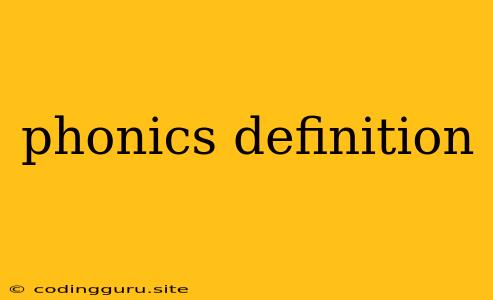What is Phonics? Understanding the Building Blocks of Reading
Phonics is a crucial component of literacy, forming the foundation for successful reading and writing. It's a method of teaching reading and spelling by focusing on the relationship between sounds and letters. Essentially, phonics helps learners understand how letters and combinations of letters represent individual sounds in spoken words.
But what exactly is phonics? Let's break it down:
The Core Principle of Phonics: Sound-Letter Correspondence
At its heart, phonics is about understanding the connection between sounds and the written symbols that represent them. When you learn phonics, you're learning that the letter 'c' can make the sound 'k' as in "cat" or the sound 's' as in "cent". Similarly, you learn that the combination 'sh' represents the sound in "ship", and so on.
Why is Phonics Important?
Phonics is a vital skill for several reasons:
- Decoding New Words: It empowers readers to decode unfamiliar words by breaking them down into their individual sounds and blending them together. This is particularly crucial for beginning readers who are learning to read independently.
- Spelling: Phonics helps learners spell words correctly by applying their knowledge of sound-letter correspondence. It allows them to sound out words and translate those sounds into written letters.
- Reading Fluency: A strong foundation in phonics contributes to reading fluency. When readers can decode words quickly and accurately, they can focus on understanding the meaning of the text, enhancing their reading comprehension.
How is Phonics Taught?
Phonics instruction typically involves:
- Explicit Instruction: Teachers explicitly explain the sounds each letter or letter combination makes.
- Practice: Learners practice identifying and producing sounds, blending sounds to form words, and segmenting words into individual sounds. This can involve games, activities, and reading aloud.
- Exposure to Decodable Texts: Children are provided with texts that primarily consist of words they have learned to decode using their phonics knowledge.
Common Phonics Terminology:
- Phonemes: The smallest units of sound in a language. For instance, the word "cat" has three phonemes: /k/, /æ/, and /t/.
- Graphemes: The letters or letter combinations that represent phonemes. For example, the grapheme 'c' represents the phoneme /k/ in "cat".
- Blending: Combining individual sounds to form a word.
- Segmenting: Breaking down a word into its individual sounds.
Phonics in Action: Examples
- "cat": The letter 'c' makes the sound /k/, the letter 'a' makes the sound /æ/, and the letter 't' makes the sound /t/. Blending these sounds together creates the word "cat".
- "ship": The letter combination 'sh' makes the sound /ʃ/, the letter 'i' makes the sound /ɪ/, and the letter 'p' makes the sound /p/. Blending these sounds together creates the word "ship".
Does Phonics Work?
Numerous studies have shown that phonics instruction is an effective approach to teaching reading and spelling. Phonics provides a systematic and structured way for learners to acquire these essential skills. It equips them with the tools they need to become confident and independent readers.
Conclusion
Phonics is a fundamental aspect of literacy development. By understanding the relationship between sounds and letters, learners can unlock the secrets of reading and writing. Phonics empowers individuals to decode words, spell accurately, and read fluently, paving the way for a lifelong love of reading and learning.
